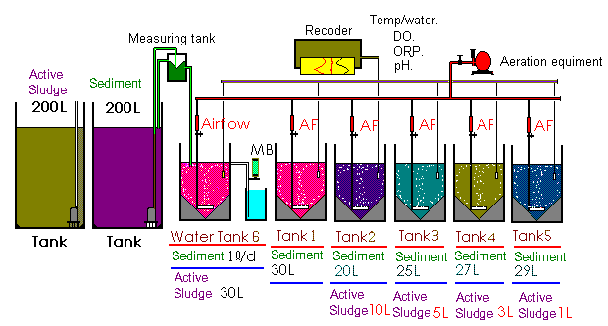
3.Testing Facility
3.1. Testing Equipment
Transparent acrylic water tanks with effective capacity of 30l were utilized during the experiments. Each bottom of the tanks was shaped V 90 degrees for smoothing circulation of sludge water and observing sedimentation of sludge .For effective combination of the bottom sediments and activated sludge for acclimation. For observation and recording the results of test progress, DO and ORP meters were installed to the tanks.
Since an appropriate mixture ratio between the bottom sediments and activated sludge was not known before tests began, five water tanks from No.1 to No.5,which given different mixture ratio, were prepared as shown in Fig.3.1. Afterward, ,examining the simplified analysis of the test result at the site, several kinds of the tests were carried out by using No.21 water tank 67 0f bottom sediments plus 33 of activated sludge in comparison with the test results of the No.1water tank 100 of bottom sediments.

Fig. 3.1: Test Equipment
_
![]()
3.2. Test Operation
The operation method of tests was done by the batch type operation which aeration and sedimentation continuously operated for a 8 hours period, and repeated a period for 3 times, that is, 24 hours were operated continuously.
These operations were automatically controlled by the previously programmed sequences. Changes in concentration of DO, ORP and pH were recorded by the instrument in each tank and functions of the bio-reactors were analyzed. Fig. 3.2 indicates the operation time chart.
|
Test term |
Aeration time + Sedimentation time |
Aeration intensity |
|
|
A |
1987/10/28-12/28 |
5.0+3.0=8hr/cycle=3cycles/day |
200Nl/hr |
|
B |
1987/12/29-1988/1/4 |
4.0+4.0=8hr/cycle=3cycles/day |
200Nl/hr |
|
C |
1988/1/5-2/08 |
3.0+5.0=8hr/cycle=3cycles/day |
50Nl/hr |

Fig. 3.2: Operation Time Chart
_
Photo 4: Bottom sediment and Improved bottom sediments.
_
Copyright
1988- 2010 Rural Environment Research Association
All rights
reserved. Any unauthorized copying and quoting prohibited.